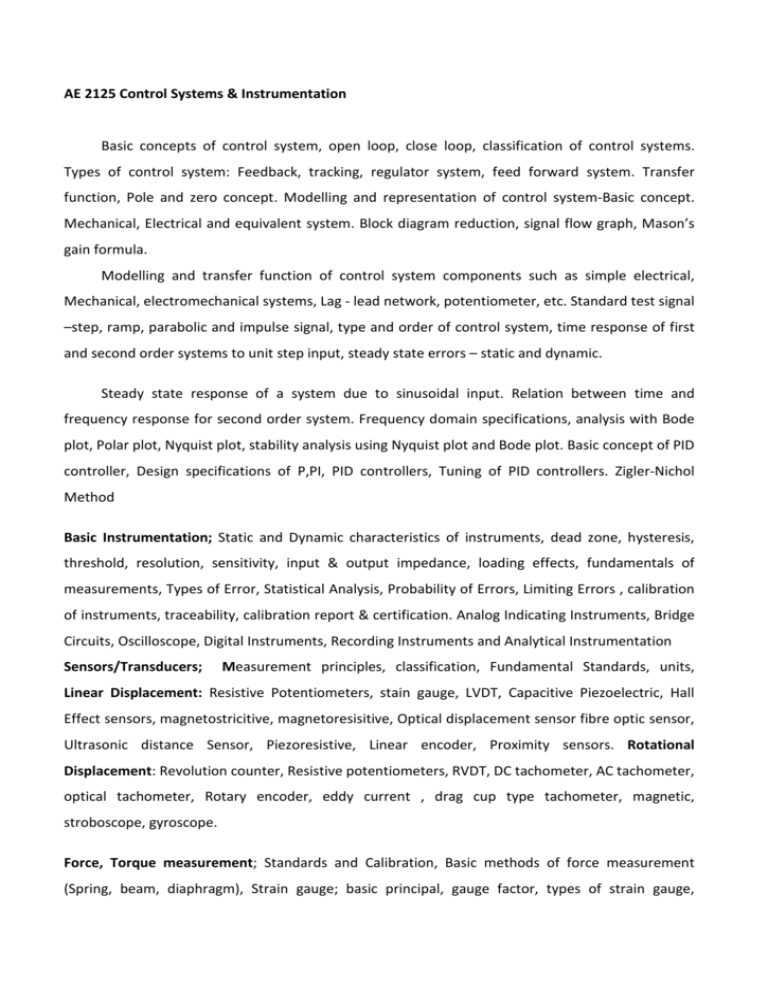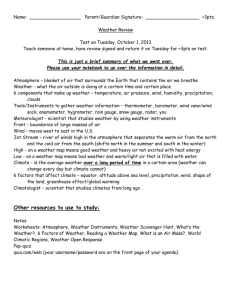AE2125 – Control Systems & Instrumentation
advertisement

AE 2125 Control Systems & Instrumentation Basic concepts of control system, open loop, close loop, classification of control systems. Types of control system: Feedback, tracking, regulator system, feed forward system. Transfer function, Pole and zero concept. Modelling and representation of control system-Basic concept. Mechanical, Electrical and equivalent system. Block diagram reduction, signal flow graph, Mason’s gain formula. Modelling and transfer function of control system components such as simple electrical, Mechanical, electromechanical systems, Lag - lead network, potentiometer, etc. Standard test signal –step, ramp, parabolic and impulse signal, type and order of control system, time response of first and second order systems to unit step input, steady state errors – static and dynamic. Steady state response of a system due to sinusoidal input. Relation between time and frequency response for second order system. Frequency domain specifications, analysis with Bode plot, Polar plot, Nyquist plot, stability analysis using Nyquist plot and Bode plot. Basic concept of PID controller, Design specifications of P,PI, PID controllers, Tuning of PID controllers. Zigler-Nichol Method Basic Instrumentation; Static and Dynamic characteristics of instruments, dead zone, hysteresis, threshold, resolution, sensitivity, input & output impedance, loading effects, fundamentals of measurements, Types of Error, Statistical Analysis, Probability of Errors, Limiting Errors , calibration of instruments, traceability, calibration report & certification. Analog Indicating Instruments, Bridge Circuits, Oscilloscope, Digital Instruments, Recording Instruments and Analytical Instrumentation Sensors/Transducers; Measurement principles, classification, Fundamental Standards, units, Linear Displacement: Resistive Potentiometers, stain gauge, LVDT, Capacitive Piezoelectric, Hall Effect sensors, magnetostricitive, magnetoresisitive, Optical displacement sensor fibre optic sensor, Ultrasonic distance Sensor, Piezoresistive, Linear encoder, Proximity sensors. Rotational Displacement: Revolution counter, Resistive potentiometers, RVDT, DC tachometer, AC tachometer, optical tachometer, Rotary encoder, eddy current , drag cup type tachometer, magnetic, stroboscope, gyroscope. Force, Torque measurement; Standards and Calibration, Basic methods of force measurement (Spring, beam, diaphragm), Strain gauge; basic principal, gauge factor, types of strain gauge, materials and their properties, bonding material compensation techniques, bridge configuration, Rosettes, Tactile sensors, Piezoelectric sensors Pressure Measurement; Standards and calibration Units and relations. Positive Pressure Sensors Manometers – U tube, Well type, inclined tube, Ring balance, Micro manometer, use of seal pots, range of measurement Elastic – Bourdon, Diaphragm, Bellows and their types, materials and their properties, range of measurement. High Pressure Measurement – Bulk modulus cell, Bridgeman type. Differential Pressure Measurement: Force balance, Motion balance, Capacitance delta cell, Ring balance DP cell. Vacuum measurement; McLeod gauge, Thermal Conductivity (Pirani, Thermocouple), hot cathode ionization gauge, Molecular momentum (Knudsen) gauge, Cold Cathode ionization (Penning) gauge. Calibrating Instruments – Dead Weight Tester (Pressure, Vacuum). Temperature measurement; Temperature Scales, Standards and Units and relations, Classification of temperature sensors. Mechanical Type, Electrical Type: Resistance Temperature Detectors – Principle, materials and their properties, Types and ranges, different sources of errors and compensations. Thermistor: Types (NTC, PTC), Measuring Circuits Thermocouple: Terminology, Types (B, E, J, K, R, S, T), determination of polarity, Sources of errors and their remedies Laws of thermoelectricity, Study of thermocouple tables (calculation of Intermediate temperature and voltage), Lead wire compensation, Cold junction compensation techniques. Non-contact Types: Pyrometers: Total Optical, Infrared Other Measurement; A) Level Measurement: Float, Displacer (Torque tube unit), Bubbler, Diaphragm box, DP cell, Ultrasonic, Capacitive, Radioactive, Resistance, Thermal, B) Density Measurement: Chain-balanced float type, Hydrometer (Buoyancy type), U tube type, Hydrostatic Head (Air bubbler, DP Cell), Oscillating Coriolis, pH Measurement, Flow Measurement: Units, Newtonian and non-Newtonian Fluids, Reynolds number, Laminar and turbulent flows, Velocity profile, Bernoulli’s equation for incompressible flow, Density, Beta ratio, Reynolds number correction, Square root relation








